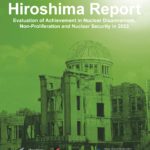(9) Transparency in Nuclear Forces, Fissile Material for Nuclear Weapons, and Nuclear Strategy/Doctrine
In the Final Document of the 2010 NPT RevCon, the NWS were called upon to report on actions taken toward “accelerat[ ion of] concrete progress on the steps leading to nuclear disarmament” to the 2014 NPT PrepCom (Action 5). All states parties to the NPT, including the NWS, were also requested to submit regular reports on implementing nuclear disarmament measures agreed at the previous NPT RevCon (Action 20), and the NWS were asked to agree on a standard reporting form as a confidencebuilding measure (Action 21).
In its Integrated Review of Security, Defence, Development and Foreign Policy published in 2021, the United Kingdom stated the following policy as imposing certain restrictions on transparency.
While our resolve and capability to do so if necessary is beyond doubt, we will remain deliberately ambiguous about precisely when, how and at what scale we would contemplate the use of nuclear weapons. Given the changing security and technological environment, we will extend this long-standing policy of deliberate ambiguity and no longer give public figures for our operational stockpile, deployed warhead or deployed missile numbers. This ambiguity complicates the calculations of potential aggressors, reduces the risk of deliberate nuclear use by those seeking a first-strike advantage, and contributes to strategic stability.214
As for the United States, the amount of information released saw a decline under the former Trump administration, which decided not to disclose information regarding the number of possessed and dismantled nuclear weapons in 2018. But the Biden administration, which took office in January 2021, changed this policy. In October, the NNSA declassified the number of nuclear weapons stockpile (including nuclear warheads deployed and in storage, but not those retired and awaiting dismantlement) for each year, including those that had not been disclosed under the previous administration. The NNSA also declassified the number of nuclear warheads dismantled of in each year.215 In the meantime, the status of nuclear weapons-related tests that did not detonate has not been updated since the first quarter of 2015, and no past information has been available since 2018.
China, in the meantime, rebutted the U.S. criticism of China’s lack of transparency, stating that its nuclear strategy and intention are more transparent and predictable, citing China’s pledge of no-first- use of nuclear weapons as well as security assurances for NNWS.216
At the 2012 NPT PrepCom, the NPDI proposed a draft form for reporting on nuclear warheads, delivery vehicles, fissile material for nuclear weapons, and nuclear strategy/policies.217 Using the draft form, the following table summarizes the degree of transparency taken by the nuclear-weapon/armed states.
214 United Kingdom, Global Britain in a Competitive Age, p. 77.
215 NNSA, “Transparency in the U.S. Nuclear Weapons Stockpile.”
216 Gu Liping, “Fu Cong: China Has Transparent and Defensive Strategy, It’s Not a Nuclear Threat,” CGTN, October 16, 2020, http://www.ecns.cn/news/politics/2020-10-16/detail-ihaazqys6709048.shtml.
217 NPT/CONF.2015/PC.I/WP.12, April 20, 2012.







